History
Building Finland’s story
Our history is not something you could tell over a single coffee break, but to get a glimpse of our story, in short it goes like this.
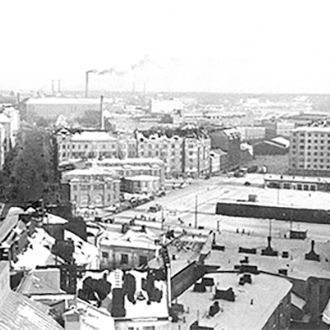
1950s
Kaukokiito Oy was founded in April 1953. The first office was located in Hakaniemi market square in Helsinki. In 1956, Kaukokiito Oy changed its name to Helsingin Kaukokiito Oy.
After the liberalisation of foreign trade in 1957, licences were no longer required for importing new lorries. Kaukokiito traffic began to expand. Regional Kaukokiito companies were established in Tampere, Turku, Lahti and other cities.
Suomen Kaukokiito Oy was established in 1958 as a nationwide umbrella organisation whose tasks included the development of the emerging international traffic operations. By the end of the decade, the Kaukokiito system had expanded to become one of the most significant goods transport systems in Finland.
1960s
At the beginning of the decade, the Kaukokiito system had more than a hundred carriers and approximately 600 lorries. The most modern goods terminal in the Nordic countries was built in Tampere in 1961. Terminals were also built in several smaller cities. Separate pick-up and delivery vehicles were taken into use in urban areas. The number of lines departing from Helsinki was 53.
After Finland joined the international TIR convention in 1960, vehicles bearing the Suomen Kaukokiito Oy emblems began to travel not only to the Nordic countries, but all the way to Central and Southern Europe. Deliveries of foodstuffs and meat products to the Soviet Union also began.
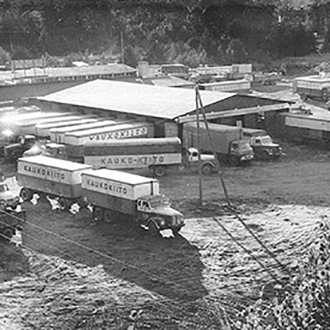
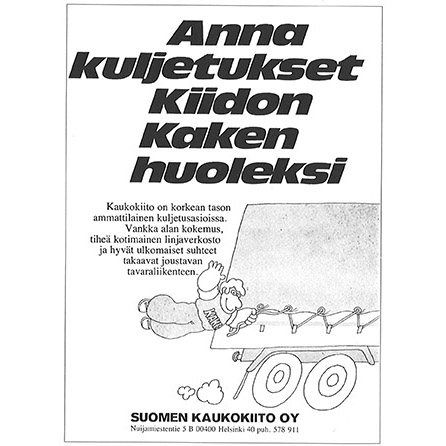
1970s
The 1970s were a period of strong expansion for the Kaukokiito system. A forest industry terminal was completed in 1970. The first warehouse hotel was built in 1973 in Voutila, Vantaa, and the computer age also began in the same year. The second warehouse hotel was built in Rahola, Tampere, in 1978. The Kaukokiito motel that opened its doors in Metsälä in 1979 opened up a new area of business for the company.
International traffic was at its peak. In addition to Scandinavia, regular traffic extended to Great Britain, Spain and Italy. Foodstuffs were delivered to Moscow and Leningrad (now St. Petersburg). The most exotic journeys were to Tehran, where the company transported eggs.
1980s
The transport industry experienced strong centralisation and competition became considerably tougher. The construction of the Myllypuro road transport centre in Tampere began in 1989 and was completed in 1991. A modern terminal was completed in the Port of Turku in 1989. With competition becoming increasingly fierce, the Helsinki terminal moved to 24-hour operations.
From 1988 onwards, Suomen Kaukokiito Oy focused solely on developing domestic cargo line traffic. The fierce depression that started at the end of the decade also had a strong impact on the transport industry.

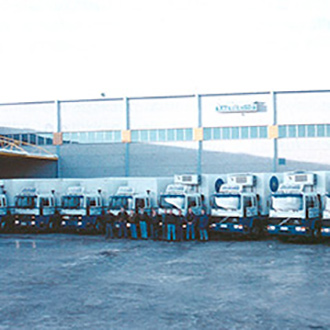
1990s
At the beginning of the decade, Kaukokiito’s pick-up and delivery functions and areas of line traffic were transferred to several partner companies. In 1992, Kaukokiito was awarded the ISO-9002 quality certificate. The traffic licence system was amended, and the traditional cargo line traffic licences were abandoned at the beginning of 1993.
Once the ownership of the Kaukokiito companies became clearer, the system was more unified than ever before at the turn of the millennium. Strong Kaukokiito carriers were responsible for traffic in their respective regions, and Suomen Kaukokiito Oy’s position as the nationwide umbrella organisation was strengthened.
2000s
At the beginning of the new millennium, Kaukokiito underwent strong growth. Investments were made in the fleet and terminals around the country. The new 15,000 m2 terminal serving the Helsinki metropolitan area was completed in Voutila, Vantaa, in spring 2005. The Kaukokiito system created uniform operating models and competitiveness improved further.
In 2003, Kaukokiito celebrated its 50th anniversary and a book on the company’s history was published.
According to the Taloustutkimus market research company, the Kaukokiito brand became one of the best-known in the transport business in the 2000s.
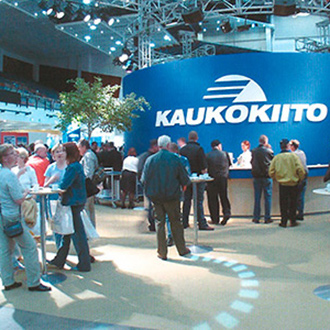
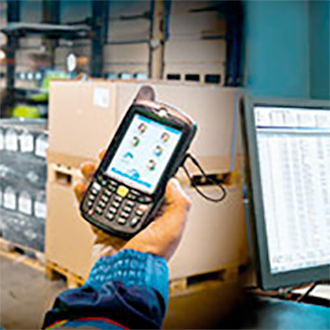
2010s
A new terminal with an area of almost 15,000 square metres was completed at Logicity in Turku in April 2010.
The new decade brought with it the new ERP system, Repsikka, that was built to meet the needs of the extensive range of services offered by Kaukokiito. The system facilitates real-time tracking at parcel level.
Repsikka is based on the Microsoft DynamicsNav system and its industry-specific vertical NaviTrans. Navitrans is a special product for logistics and production control made by the Belgian company, Young & Partners. NaviTrans is used by hundreds of companies around the world. Repsikka is the largest NaviTrans implementation in the world. It was taken into use in January 2013.
As late as 2010, Kaukokiito’s transport orders were primarily made by telephone or e-mail. Transport pick-up data was stored in the system, which relayed information to drivers by SMS. Delivery was planned using paper waybills, which were scanned and interpreted in the invoicing system manually. During the 2010s, the rate of digitalisation has increased to over 90% in Kaukokiito. This means that the customer’s electronic order is sent automatically to production planning and, ultimately, invoicing. Digitalisation has taken operations increasingly close to a no-waybill operating method.
That is our story in short. Admittedly, such a short story does not give the deserved credit to our fine history, but we hope that it shows you that we are a reliable, forward-looking Finnish logistics company that exists for your shipments.

